The metaverse is rapidly evolving, and its potential for groundbreaking experiences across various industries is undeniable. But for startups brimming with innovative ideas, a crucial question remains: how much does it cost to develop a metaverse platform?
This guide delves into the world of metaverse development cost formation, providing valuable insights for startups of all stripes. Understanding these costs empowers you to make informed decisions and approach development strategically within your budget.
The Metaverse: A Gateway to Limitless Experiences
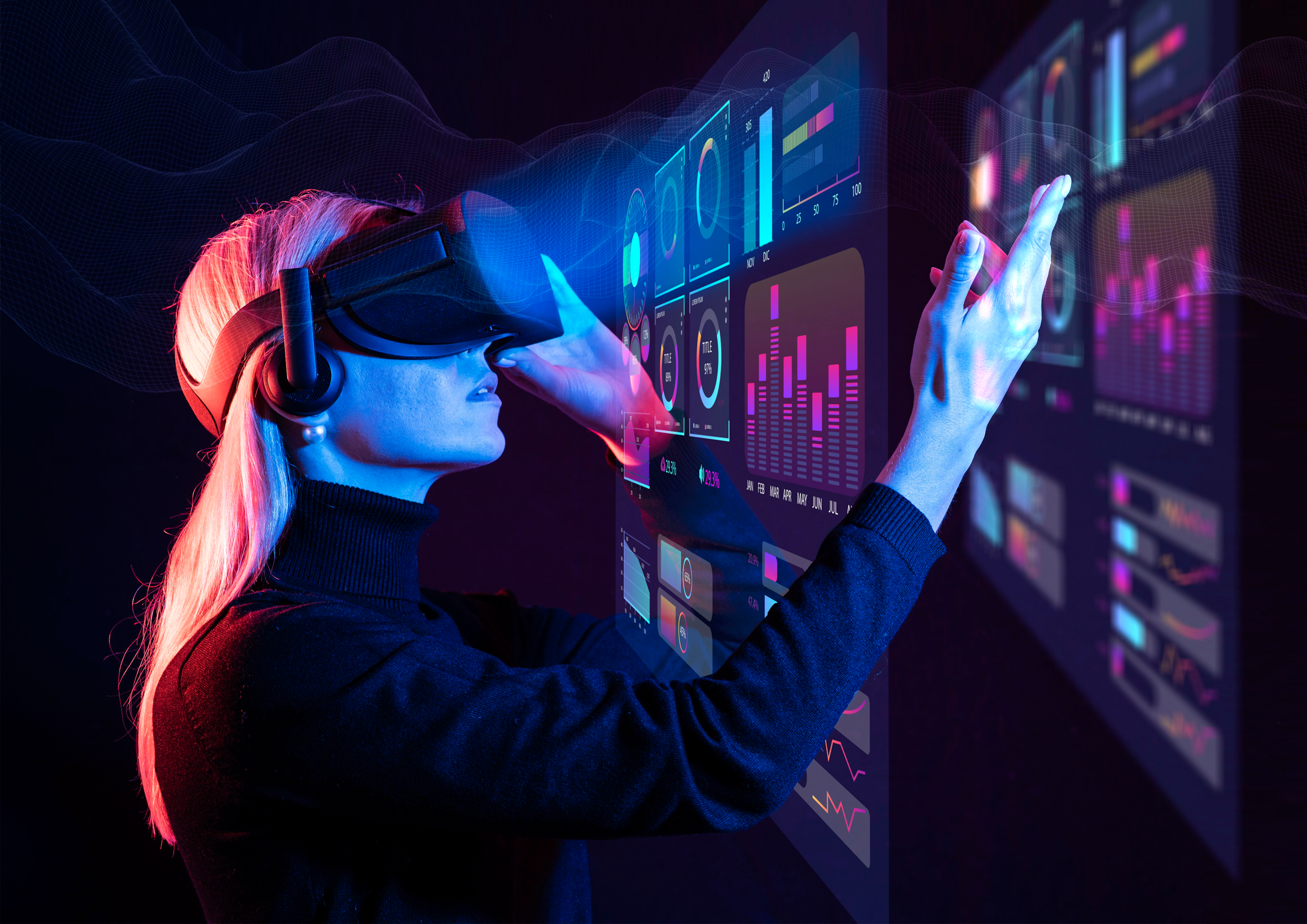
Source: Freepik
The metaverse is a rapidly evolving concept that promises to revolutionize the way we interact with technology and each other. Heavily influenced by virtual reality (VR) technology, the metaverse offers a gateway to immersive experiences that transcend the limitations of the physical world. Imagine stepping into a virtual world where you can:
- Explore: Wander through meticulously crafted virtual landscapes, historical landmarks, or even alien planets.
- Connect: Meet and socialize with friends and colleagues from anywhere in the world, all within a metaverse environment.
- Learn: Immerse yourself in interactive educational experiences that bring complex subjects to life.
- Create: Build, design, and share virtual spaces, objects, and experiences with others.
- Shop: Browse virtual stores, try on clothes virtually, and decorate your digital avatars with unique accessories.
- Work: Collaborate with colleagues in real-time within a shared virtual workspace, regardless of physical location.
- Attend Events: Immerse yourself in virtual concerts, conferences, and live performances, experiencing them from a front-row seat.
Unlocking Possibilities: The Power of VR in the Metaverse
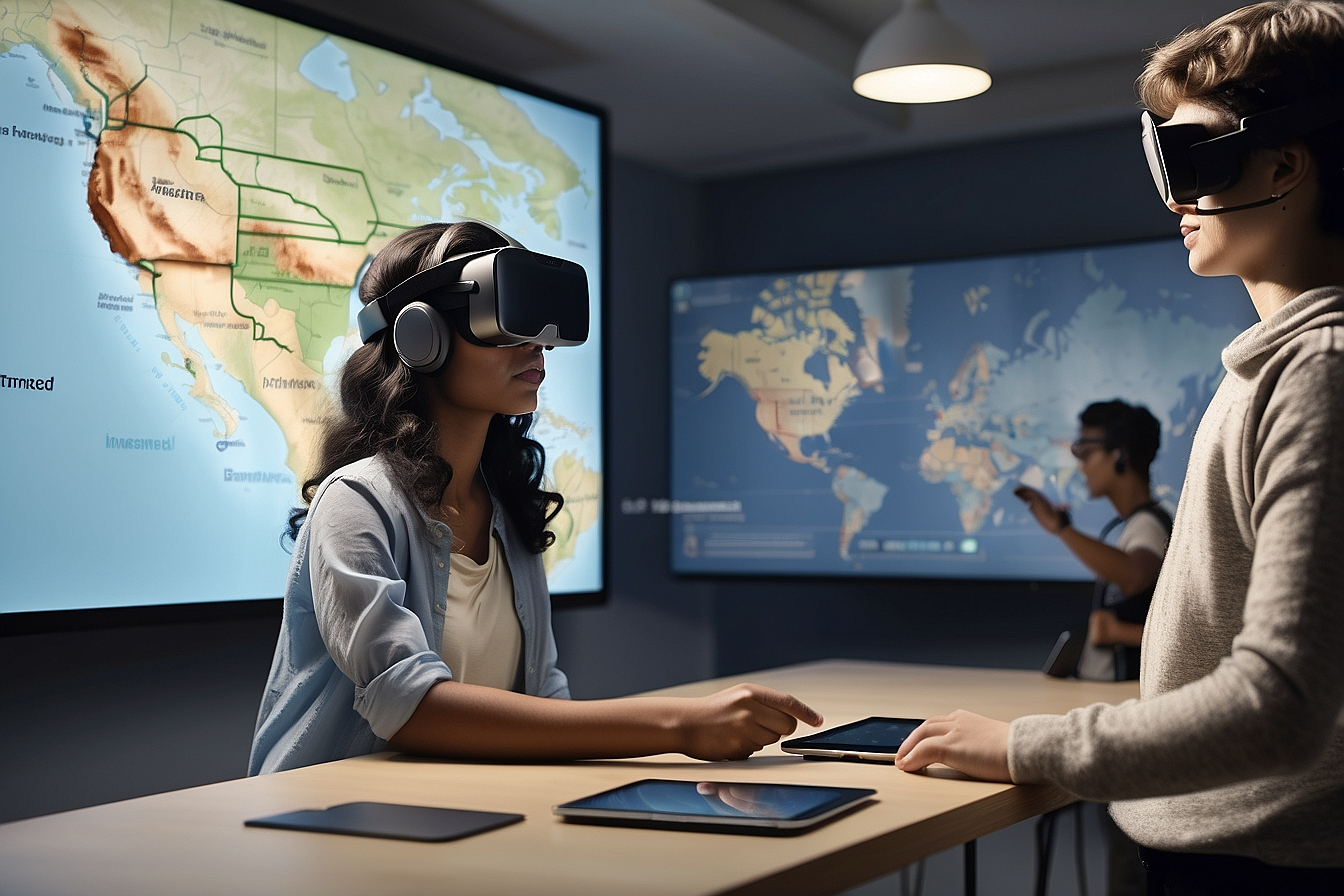
VR technology adds a powerful layer of immersion to the metaverse, allowing users to truly feel like they are physically present within the metaverse ecosystem. This opens doors to a vast array of possibilities across various industries and applications:
- Education: Imagine attending a history lecture where you can walk the battlefields of ancient Rome or explore the inner workings of the human body.
- Retail: VR showrooms can allow customers to try on clothes, furniture, or even makeup in a realistic setting before making a purchase.
- Architecture and Design: Architects and designers can collaborate in real-time on 3D models of buildings and interiors within a metaverse environment.
- Healthcare: Medical professionals can train in realistic VR simulations, practicing complex procedures before performing them on real patients.
- Social Interaction: The metaverse can foster new forms of social interaction and connection, allowing people to build relationships and communities regardless of physical distance.
The potential applications of the metaverse are truly limitless. By understanding its potential, individuals and businesses alike can position themselves to thrive in this exciting new frontier.
Unveiling the Metaverse: A Roadmap to Your Virtual Reality
The metaverse beckons, offering a canvas to redefine connection, collaboration, and innovation. But before embarking on your digital odyssey, understanding the development process is key. This guide explores the factors that influence metaverse creation, empowering you to craft a captivating experience tailored to your vision.

- Conceptualization and Design: Brainstorming ideas is crucial. User experience (UX) design principles and storyboarding your multiple worlds lay the groundwork for a successful metaverse.
- Development Stages:
- Backend Infrastructure: Building the foundation for your metaverse, including servers, databases, and security measures.
- User Interface (UI) Development: Crafting a user-friendly and immersive interface for users to navigate your digital world.
- Functionality Integration: Implementing core functionalities like digital avatars, networking, content creation tools (if applicable).
- Project Management: Utilizing project management methodologies like Agile development ensures efficient and streamlined metaverse creation.
Metaverse Development Cost Breakdown
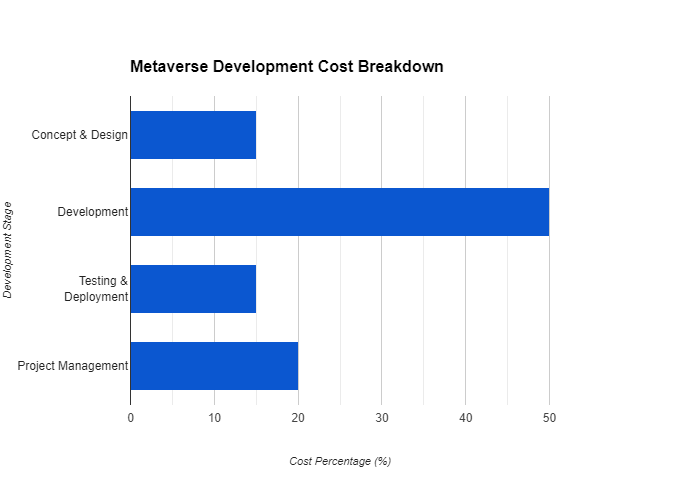
Understanding how development costs are distributed across different stages of metaverse project can help you make informed budget decisions. Here’s a simplified breakdown of the average percentage allocation for each phase:
Concept & Design (15%)
- Brainstorming workshops to define the core functionalities and overall user experience.
- User experience (UX) design, including user flows and wireframes for the virtual environment.
- Storyboarding the narrative arc and key interactions within the metaverse.
Development (50%)
- Building the backend infrastructure, including servers, databases, and security measures to handle the virtual world.
- Integration of VR functionalities (if applicable), including 3D environment creation, physics simulations, and haptic feedback.
- Development of core metaverse functionalities like avatar creation, social engagement, and content creation tools (depending on the project scope).
Testing & Deployment (15%)
- Rigorous testing to ensure a smooth user experience across various platforms (if applicable).
- Bug fixing and performance optimization for the metaverse environment.
- Deployment to the chosen platform (e.g., web-based, VR headset-specific).
Project Management (20%)
- Overseeing the entire development lifecycle, ensuring milestones are met and resources are managed effectively.
- Coordinating communication between designers, developers, and other stakeholders.
- Adapting to project changes and unforeseen challenges.
Please note: These are estimated percentages, and the actual allocation might vary depending on the specific project’s complexity and requirements. Consulting with experienced metaverse development professionals is crucial for obtaining a more accurate cost breakdown tailored to your specific needs. This is because the cost to develop a metaverse experience can vary significantly depending on several factors, such as project complexity, desired features, and chosen development approach. Seasoned professionals can guide you through these factors and provide a clear picture of the development costs involved in bringing your unique metaverse vision to life.
Estimating Metaverse Development Cost: A Practical Guide
Metaverse development cost rates vary depending on your unique project. Here are some key factors to consider that influence the overall development cost:
Project Complexity
- Project Scope: Clearly define the core functionalities and overall experience you aim to create. A social metaverse will differ significantly from a complex VR training simulation.
- Level of Detail: The intricacy of your virtual worlds significantly impacts cost. Highly detailed landscapes, diverse structures, and realistic textures require more resources compared to simpler, stylized environments.
- VR Integration: VR adds complexity and cost. Consider the extent of VR integration. Simple VR elements like 360° environments have a lower cost impact compared to intricate VR interactions with physics simulations and haptic feedback.
Development Considerations
- Development Team: Building an in-house team with VR expertise requires hiring specialists, which can be expensive.Outsourcing to a team with established VR experience can be a cost-effective option for navigating the metaverse market. This leverages their existing knowledge and avoids the time and expense of building your own VR development team from scratch.
- Timeline and Ongoing Maintenance: Complex projects with longer timelines will naturally cost more. Additionally, consider ongoing maintenance costs for updates, bug fixes, and potential future feature additions.
The Metaverse Tech Stack: A Balancing Act of Features and Costs
The intricate interplay of technologies within the metaverse directly impacts development costs. Integrating advanced features requires specialized expertise and development time, leading to higher costs. This “metaverse tech stack” can include elements like VR, AR, and complex artificial intelligence functionalities.
For example, building an experience with intricate VR interactions and physics simulations, or seamlessly blending the physical and virtual worlds with augmented reality, will naturally cost more compared to a simpler social environment that relies on a less complex tech stack. However, there’s good news! Seasoned metaverse development teams can help you navigate these complexities. They can recommend cost-effective approaches to technology integration, focusing on features and functionalities that deliver the core experience you envision, all within your budget.
Here’s a simplified approach to estimating costs based on project complexity
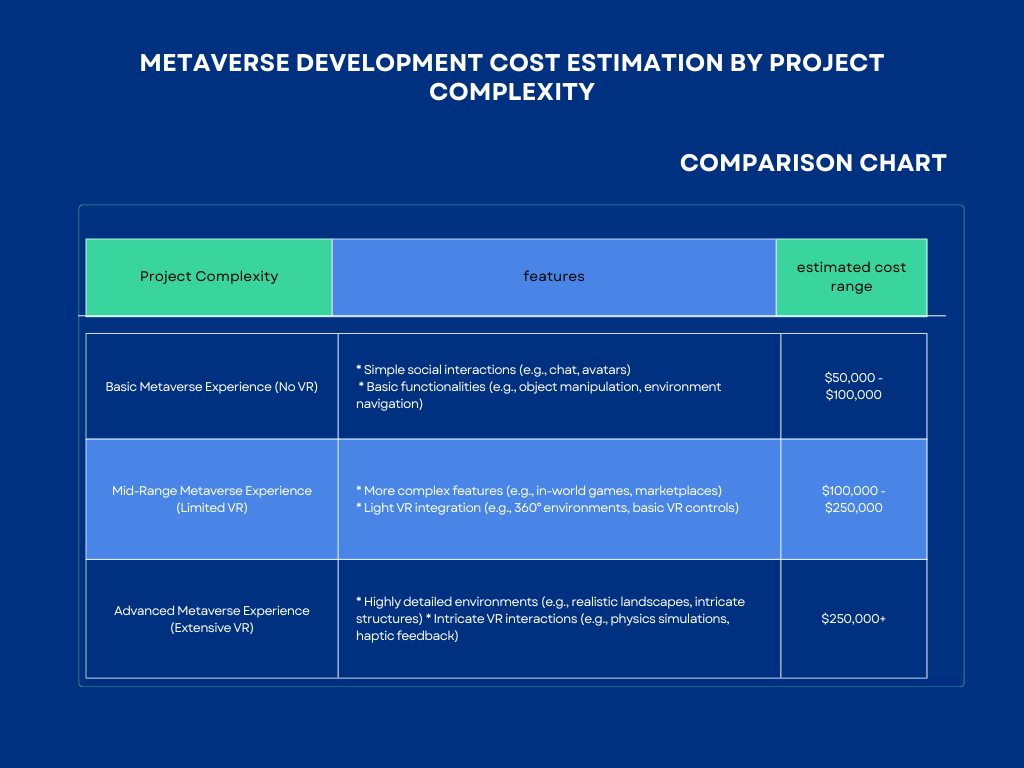
- Basic Metaverse Experience (No VR): $50,000 – $100,000 (Simple social interactions, basic functionalities)
- Mid-Range Metaverse Experience (Limited VR): $100,000 – $250,000 (More complex features, light VR integration)
- Advanced Metaverse Experience (Extensive VR): $250,000+ (Highly detailed environments, intricate VR interactions)
Remember: These are ballpark figures. It’s crucial to consult with experienced metaverse development professionals who can assess your specific needs and provide a more accurate development cost estimate. They can help you identify cost-saving strategies and prioritize features to stay within your budget.
By following this practical guide and consulting with development experts, you can gain a clearer understanding of the metaverse development cost associated with your unique project. This empowers you to make informed decisions and approach development with a realistic budget in mind.
Building Your Virtual World: Crafting Your Metaverse Experience
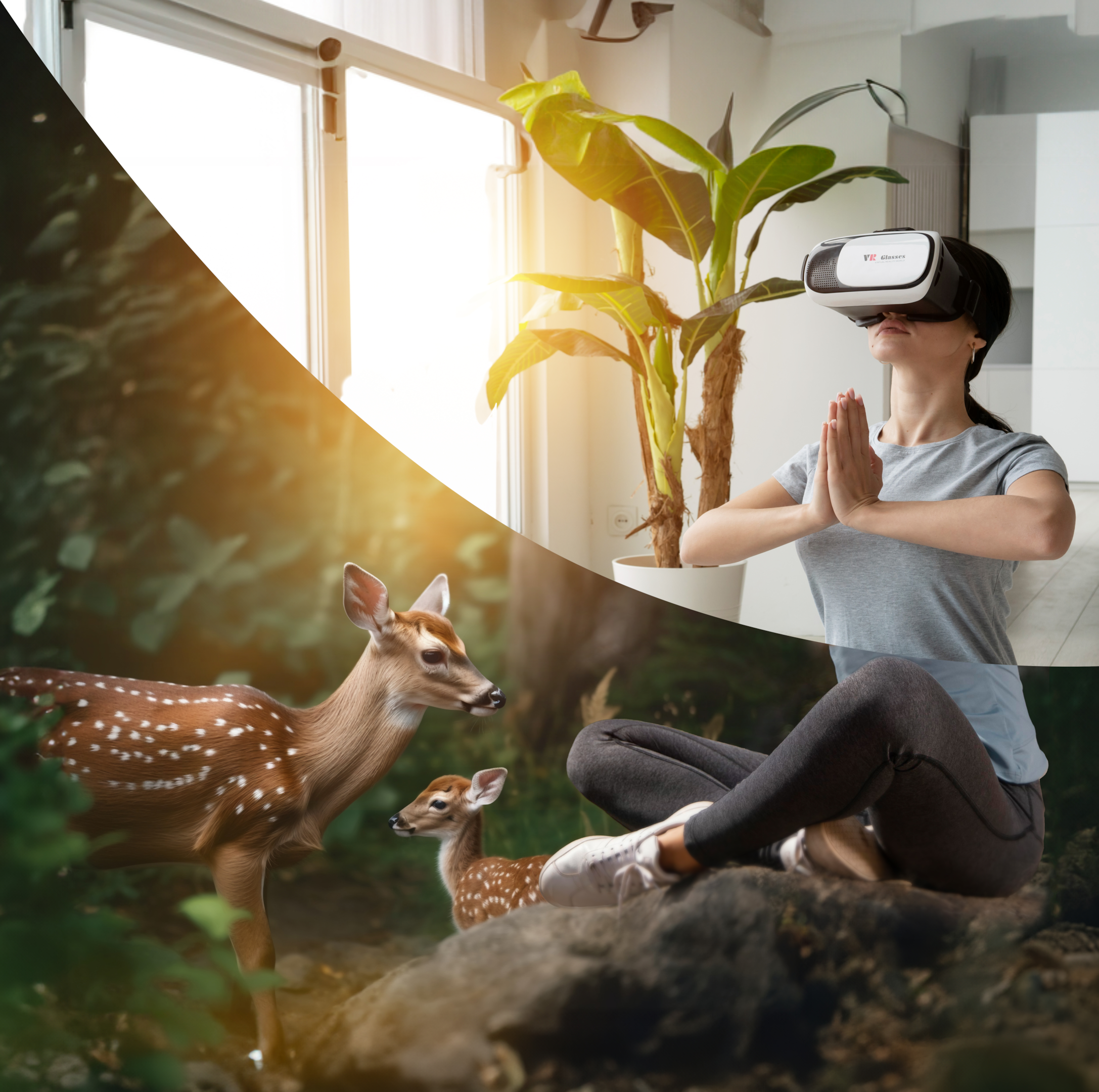
Source: Freepik
Developing a metaverse, whether VR-integrated or not, is a complex but rewarding journey. This simplified roadmap will guide you through the process of building a bridge between the physical and digital worlds.
Step 1: Charting Your Course – Conceptualize Your Metaverse Experience
- Define the purpose: What unique value will your metaverse offer to users? Is it a social gathering space, a metaverse platform, a virtual training ground, a collaborative workspace, or something entirely new?
- Identify your target audience: Who will inhabit your virtual world? Understanding their demographics and preferences will shape your design choices and overall experience.
- Plan the functionalities: Carefully consider the core functionalities that will define your metaverse experience. This includes how users will interact: text chat, voice chat, avatars, or a blend? Will you incorporate immersive elements, even if not full VR integration? Additionally, consider the potential role of artificial intelligence (AI) within your metaverse platforms. AI can be used for various purposes, such as powering realistic non-player characters (NPCs), personalizing user experiences, or even moderating content.
Step 2: Building the Foundation – Crafting the Virtual Landscape
- Design the visual environment: Create a visually captivating world that aligns with your metaverse’s purpose. Consider factors like landscapes, structures, and overall atmosphere.
- Focus on User Experience: Design the environment with a focus on user experience, ensuring easy navigation and clear communication, regardless of the chosen interaction method (VR or otherwise). This includes intuitive layouts, clear signage, and accessible features.
Step 3: Designing for User Interaction: Building an Intuitive Interface
- Design user interfaces (UI) and user experience (UX) that are easy to understand and navigate for your target audience. Consider the chosen interaction methods (text chat, voice chat, avatars, etc.) and prioritize user comfort.
- Optimize for Different Access Levels: If VR integration is planned for the future, ensure the core functionalities are accessible through non-VR interfaces as well.
Step 4: Powering the Metaverse – Building the Backend Engine
- Develop the server-side infrastructure, often called the “backend,” that powers your metaverse’s functionalities. This includes features like user authentication, data storage, and real-time communication.
- Scalability and Performance: Plan for scalability to accommodate a growing user base and ensure smooth performance, regardless of the chosen interaction method.
Step 5: Prioritizing Security: Safeguarding Your Metaverse Platform
- Fort Knox Logins: Use multi-factor authentication (MFA) for strong account security.
- Data Encryption: Encrypt user data to keep it safe.
- Combat Abuse: Proactively address fraud and inappropriate behavior.
Step 6: Refining Your Creation: Testing and Iteration
- Rigorously test your metaverse for functionality, security, and user experience.
- Focus on Core Interaction Methods: Pay close attention to the core user interaction methods (text chat, voice chat, avatars, etc.) ensuring they are smooth, intuitive, and comfortable for users.
- VR Integration Testing (if applicable): If VR integration is part of the plan, conduct thorough VR testing to identify and address any potential usability issues or discomfort.
By following these steps, you can navigate the metaverse platform development process and build a compelling metaverse experience for your users, with or without VR integration. Remember, the core principles remain the same – create a captivating interactive virtual world that caters to your target audience’s needs.
Industry-Specific Applications: The Power of Interaction in the Metaverse
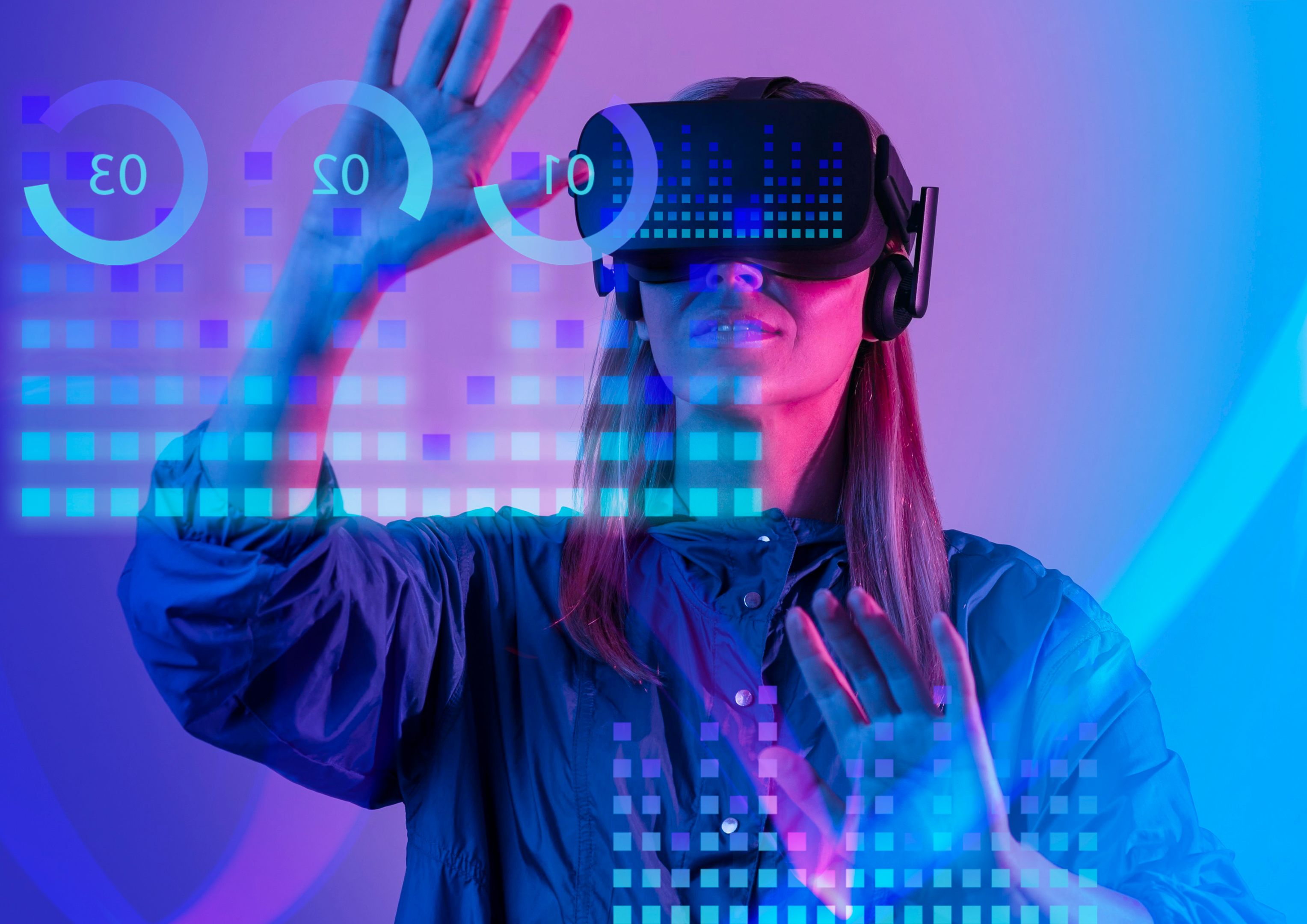
Source: Freepik
The metaverse, with or without virtual reality integration, offers exciting opportunities for businesses across various industries. Here’s how different sectors can leverage the power of interaction within the metaverse platform.
Enhanced Customer Engagement:
Retail: Create virtual showrooms where customers can browse products in 3D, interact with virtual assistants, and even try on clothes or furniture virtually.
Travel and Hospitality: Offer immersive virtual tours of destinations, allowing potential tourists to explore hotels, resorts, or landmarks before booking a trip.
Education: Host interactive lectures or workshops within the metaverse platforms, where students can engage with educators and each other in captivating metaverse world.
Revolutionized Training and Collaboration:
Manufacturing and Engineering: Train employees on complex machinery or assembly procedures using interactive simulations within the metaverse.
Architecture and Design: Facilitate collaborative design sessions where architects and designers can work together on 3D models of buildings and interiors in real time, regardless of physical location.
Healthcare: Train medical professionals in realistic virtual simulations for surgery or other procedures, enhancing skills development and patient safety.
Unveiling New Revenue Streams:
Virtual Events: Host virtual concerts, conferences, or product launches within the metaverse, reaching a global audience and generating revenue through ticketing or virtual merchandise sales.
Virtual Advertising: Develop innovative advertising formats within the metaverse app, allowing brands to target users with interactive and immersive experiences.
Virtual Goods and Services: Create and sell virtual products like clothing or accessories for avatars, or offer virtual services like consultations or experiences within the metaverse app.
These are just a few examples. The potential applications of the metaverse are vast and constantly evolving. By understanding the power of interaction within this virtual space, businesses can unlock new avenues for growth, innovation, and customer engagement.
Conclusion: Embrace the Metaverse

Source: Freepik
The metaverse has arrived, opening a gateway to deeper connections, collaborative experiences, and boundless innovation. This guide has equipped you to navigate the metaverse platform building process, understand key factors influencing metaverse platform development cost, and explore the vast potential this technology holds across various industries.
Embrace the Metaverse to:
- Revolutionize Engagement: Foster deeper connections with immersive experiences.
- Unlock Revenue Streams: Develop a metaverse space with virtual products and services.
- Empower Your Workforce: Train and collaborate in your own virtual space.
- Push Boundaries: Experiment with new ideas within the metaverse.
The metaverse is a vast and evolving canvas. With planning, creativity, and a well-informed approach to development costs, you can redefine your brand, connect with your audience in innovative ways, and establish yourself as a pioneer in this new frontier. The metaverse market is brimming with potential, and the journey begins now. Take the first step and start crafting your story within this immersive new world.



